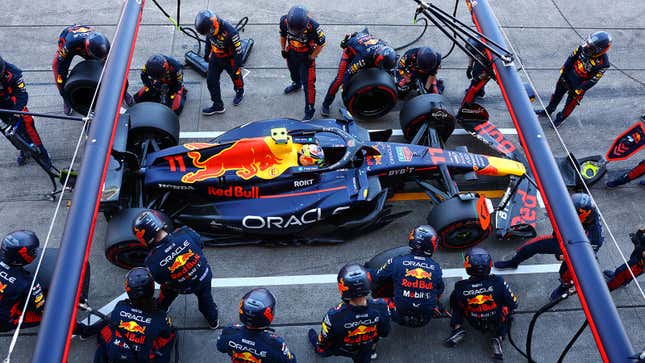It Takes 24 People To Pull Off A Two Second F1 Pit Stop

People watch Formula 1 for all sorts of reasons; maybe it’s the on-track action, the off-track drama or the mind-bending technology on display in each race car. For some, it could even be the synchronized beauty that is the sub-three second pit stops that every team carries out each race. If that’s the kind of thing that floats your boat, then good news! We’re about to take a deep dive into everything that has to fall into place for the perfect F1 pitstop.
Nick Offerman On The Freedom Of Getting An Airstream RV
The record for the new regulation pit stops in F1 stands at 1.8 seconds, which was set by McLaren during the Qatar Grand Prix when it swapped Lando Norris’ four aging tires for four new ones in the blink of an eye. The stop required a team of around 20 people, each tasked with a very specific role that’s been broken down in a new report from the Washington Post.
In each team, there are engineers that lift the car up on jacks at the front of the car, a person stands on either side of the car to steady it and a trio of engineers makes the tire change at each corner of the car. Plus there are backup engineers at the jacks and tires as well. As the Post explains:
A “wheel-off” mechanic grabs the old tire, and a “wheel-on” mechanic slides the new one into place. The wheel-gun man — most pit crew mechanics are men — loosens and tightens the wheel nut. At most stops, two mechanics adjust the front wing flap angle.
Other team members act as spotters, perform other minor car maintenance and stand by with fire extinguishers, backup equipment and extra tools and parts.
There’s a car in there… somewhere. Photo: SIMON WOHLFAHRT/POOL/AFP (Getty Images)
All this means that an average pitstop in F1 takes less than three seconds thanks to a team of around 24 people, including the driver. In contrast, drivers in IndyCar wait around eight seconds for a wheel change, and NASCAR crews take almost 10 seconds to change all four tires.
Perhaps making this all the more impressive, engineers carrying out an F1 stop usually only get around 30 seconds warning before they have to rush into action, the Post reports. When that happens, the wheel-on engineer grabs a new tire that’s wrapped in a blanket to heat it up to 158 degrees Fahrenheit. Twenty seconds before the car reaches the pit, that blanket is dropped and the crew runs out to their position in the pit box.
Then, the car finally rolls into the box and stops on a set of markers that ensures everyone is in the right place for the task at hand. As the Post explains:
It is the trickiest part of a pit stop for a driver, the four Haas and Red Bull drivers said through team spokespeople.
“You want to get from whatever the pit limiter is to zero in as shortest time as possible, all while hitting your marks — not stopping too long or too short,” said Kevin Magnussen of Haas.
Two engineers then lift the car up, before it’s steadied in place by another two team members. The wheel gunners then loosen the bolts, before one worker pulls the old tire off and another slides the new one into place and the bolt is tightened once again. On each wheel, the bolt stays in place, so there’s no fumbling around for the right fitment, which would cost valuable milliseconds.
Another pair of engineers could then swoop in to adjust the levels on the front wing and change the downforce it produces. After that, the car is dropped back to terra firma, given the green light and speeds out the pit lane.

Around 20 people will be hands on with an F1 car when it comes into the pits. Photo: Mark Thompson (Getty Images)
The whole process is a minuscule moment over the course of an F1 race, which can run for about 90 minutes, but it can be make or break for a team’s result. As such, the people undertaking the pitstop train for hours on end to perfect their positions. The Post explains:
Team members largely credited two people for the time improvement: performance coach/physiotherapist Faith Atack-Martin and strategy engineer Faissal Fdil. The pair work together, poring over videos and data to detect the places where the crew can pick up tiny slivers of time.
Atack-Martin trains the crew on strength, core stability and mobility, which cuts down on injuries in their regular team roles in addition to making them fitter for pit stops. They learn strategies to better deal with stress and use visualization techniques to prime their minds and muscles for action.
Rather surprisingly, to me at least, was the revelation that the pit crew all have another job within the team that they’ll carry out over the rest of the weekend. This, according to the Post, is because of limits on personnel that teams are allowed to take to each race, so some pit crew will be mechanics who help assemble the cars in the buildup to a race and others might have wildly different jobs within the team.

Three people work on each corner of the car. Photo: BEN STANSALL/AFP (Getty Images)
The Post’s breakdown makes for a fascinating read for any F1 fan out there. It goes into great detail about the kit used by teams and even breaks down tire strategy that the teams will use over a grand prix. If you want to find out more about the makeup of an F1 pitstop, you can read the whole breakdown right here.



